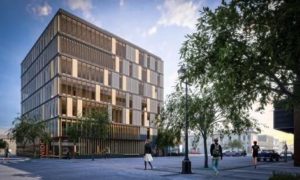*Traduction en français disponible ici.*
 Attending the MegaFlorestais Next Generation of Forest Agency Leaders 2013 from May 27-31, 2013 in Oaxaca was an inspiring experience: there were dynamic discussions, inspiring lectures and captivating study tours showing how advances in forest management support local development. One of the highlights of our trip was the visit to the the Ixtlán de Juarez community and Ecoturixtlán, its eco-tourism facilities, which was truly inspiring. During the field trip, we learned how people were working together at the local, state and industry levels to support various forestry operations (sawmill, furniture factory, nursery, etc.) that would in turn generate revenues that were reinvested in local projects and people. One of the most impressive aspects was the scale of the operations that punched well above their weight in impact at the local level by ensuring jobs, funding local charitable projects and conserving local forest resources through environmental practices that sustain cultural, social and economic resiliency.
Attending the MegaFlorestais Next Generation of Forest Agency Leaders 2013 from May 27-31, 2013 in Oaxaca was an inspiring experience: there were dynamic discussions, inspiring lectures and captivating study tours showing how advances in forest management support local development. One of the highlights of our trip was the visit to the the Ixtlán de Juarez community and Ecoturixtlán, its eco-tourism facilities, which was truly inspiring. During the field trip, we learned how people were working together at the local, state and industry levels to support various forestry operations (sawmill, furniture factory, nursery, etc.) that would in turn generate revenues that were reinvested in local projects and people. One of the most impressive aspects was the scale of the operations that punched well above their weight in impact at the local level by ensuring jobs, funding local charitable projects and conserving local forest resources through environmental practices that sustain cultural, social and economic resiliency.
THE CHANGING NATURE OF PARTNERSHIPS
The forest sector, and as a result forest agencies all over the world, are in transition. Major shifts are happening in the sector, including tenure reform, decentralization and the emergence of bio-products as a way to derive full value from forest fiber. These global trends are influencing the forest sector and are providing opportunities to local organizations to adopt newer technologies. New models of governance, both for governments and industry, as well as collaboration with traditional and non-traditional partners represent potential ways forward for the sector to emerge as a transformed industrial sector. The operations at Ixtlán de Juarez illustrate how innovative partnerships present a source of sustainable revenue generation and hope for the future. Working collaboratively in partnership between local governments, indigenous people, forestry operators and state governments has fostered change that any single organization may not have been able to carry out in isolation.
Like the many people we met in Oaxaca, the leaders of tomorrow will need to be comfortable seeking and navigating partnerships with traditional and non-traditional collaborators. The forest sector is currently transforming, and innovation, including in our relationships, is part of this transformation, which bodes well for bringing new energy, new ideas and fresh perspectives.
EXAMPLE: HIGH RISE WOOD BULDING DEMONSTRATION PROJECT(S) EXPRESSION OF INTEREST
On our return, we began searching for examples of similar types of collaborative projects in Canada. Our country has a long history of using wood in construction. Builders, designers and architects are seeking safe, cost-effective, carbon-neutral and sustainable building alternatives. Wood is a building material ideally suited for this need. Not surprisingly, there is a growing interest to using wood in mid-rise (up to 6 storeys), high rise (10 storeys and more) and non-residential construction (long-term care facilities, shopping centres, recreational facilities etc.).
More recently, science is being undertaken to address some of the challenges associated with the use of wood in the construction of high-rise buildings in Canada, which have prevented their wider adoption. This is primarily due to existing building codes and standards which relate to using wood in building construction. Natural Resources Canada (NRCan), in collaboration with its partners, has been supporting the research and testing to allow for the development of revisions to the National Building Code of Canada to make it easier to design and build taller wood structures. These code changes are expected to be reflected in the 2015 edition of the National Building Code.
In May 2013, the Canadian Wood Council, with funding support from NRCan, issued a request for an Expression of Interest (EOI) for Canadian developers, institutions, organizations and design teams willing to undertake an innovative approach to designing and building high-rise demonstration projects. The objective of this initiative is to identify building project, within Canada, which safely and successfully demonstrate the use of wood as a viable structural element/system in buildings of 10-storeys and more. FPInnovations, a research organization, and the National Research Council will provide scientific and technical support to the partners and project proponents on the tall wood building initiative.
This initiative will put forward projects that have the opportunity to demonstrate this success in North America, under North American conditions and performance requirements. Viable and innovative building solutions can create strong markets for wood products, increase this country’s ability to generate jobs in the traditional forest sector and in the forest sector of the future, and support local communities.
Amélie Roberge & Trudy Samuel
Canadian Forest Service, Natural Resources Canada
Participants in the 2013 Next Generation of Forest Agency Leaders Seminar
PHOTO: Rendition of the Wood Innovation Design Centre (Michael Green Architecture)
